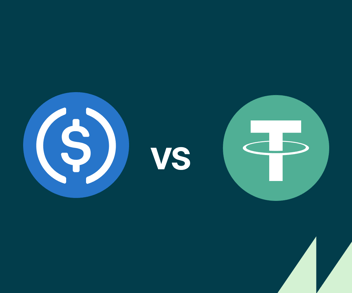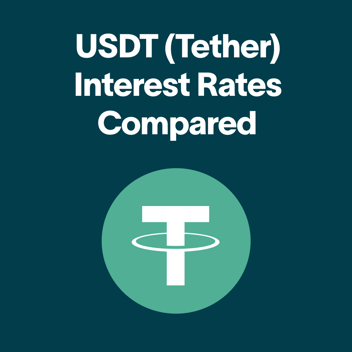USDT Staking - What you need to know

What Is Tether (USDT)?
Before getting into staking, let's recap what Tether (USDT) is. USDT is a type of cryptocurrency known as a stablecoin. It’s run by a company called Tether. Unlike Bitcoin or Ethereum, which can be quite volatile, USDT is designed to maintain a stable value by being pegged to the US Dollar. One USDT is designed to be equal to one dollar. For every USDT, there's a dollar in reserve, making it a "stable" digital asset.
If you’d like to learn more about USDT, check out our article What is USDT?
What Is USDT Staking?
USDT staking refers to the act of depositing USDT tokens into various platforms to earn interest. It differs from traditional staking, where participants engage in a blockchain's consensus mechanism, often proof-of-stake, to validate transactions and secure the network, earning rewards in the native cryptocurrency. Although USDT staking is often compared to actual staking seen on proof-of-stake blockchains like Ethereum and Polygon, the underlying mechanisms are different. However, for the end user, both methods offer avenues for earning interest.
Pros and Cons of USDT Staking
Staking your USDT can be an attractive option, but it's important to weigh the benefits and drawbacks.
Pros:
Earning Potential: Staking USDT often yields higher returns compared to traditional savings accounts.
Accessibility: Getting started with USDT staking is relatively straightforward, with numerous platforms providing easy-to-use staking services.
Stablecoin Advantage: Since USDT is a stablecoin, it offers less price volatility compared to other cryptocurrencies, making staking rewards more predictable.
Inflation-Resistant Rewards: Earnings from staking can potentially outpace inflation, preserving the purchasing power of your holdings.
Cons:
As is true of any investments that result in yield, there is always the potential risk of losing the digital assets that you stake. This could happen for a number of reasons.
Market Risks: Despite USDT's stability, the broader cryptocurrency market is volatile, and external factors can impact the staking ecosystem.
Liquidity Issues: Once staked, your USDT might not be immediately accessible, limiting your ability to use or trade these funds swiftly.
Complexity: For beginners, understanding the nuances of staking, including the platforms and terms involved, can be daunting.
Regulatory Uncertainty: The evolving landscape of crypto regulations can affect staking processes and rewards.
Dependence on Platform Stability: Your staking experience and returns depend on the stability and reliability of the chosen staking platform.
Can I earn digital assets from staking Tether?
Earning digital assets from staking Tether (USDT) depends on various factors such as the staking platform's interest rate and the amount of USDT you stake.
For example, if a platform offers an annual percentage yield (APY) of 10% and you stake $1,000 worth of USDT, you could potentially earn $100 in USDT over the course of a year, assuming the rate and staked amount remain constant.
It's always essential to consider your risk tolerance and budget. Staking involves locking up your USDT. In return, you earn rewards, typically in the form of additional USDT. However, this process isn't without risks, and the rewards depend on the staking platform and the amount of USDT you stake.
Is USDT Staking Legal?
Staking USDT is legal, but it's subject to specific rules and regulations depending on your location. Various platforms offer staking services, and each has its own set of rules, fees, and reward or interest rate structures.
Best USDT Staking Platforms
Each of these platforms offers unique benefits and features for staking USDT. When choosing a platform, consider factors like interest rates, security measures, ease of use, and the platform's overall reputation in the crypto community. Remember, while staking can offer attractive returns, it's important to understand the associated risks and conduct thorough research before committing your funds.
Nexo
Nexo is a well-regarded centralized platform offering competitive interest rates on USDT deposits. Its high annual percentage yields (APY) can surpass traditional financial products, with rates partly enhanced by the distribution of NEXO tokens (something to consider). It combines ease of use with robust security measures, making it a good choice for both novice and experienced crypto holders looking to stake USDT.
Stargate Finance
This decentralized platform operates as a cross-chain stablecoin bridge. By depositing USDT on Stargate Finance, users can contribute to liquidity pools across various networks like Ethereum, Avalanche, Polygon, Arbitrum, Optimism, and Fantom. The platform rewards users for providing liquidity, facilitating seamless transactions across different blockchains. Its decentralized nature minimizes risks like fund freezing, making it a safer option for USDT staking.
AAVE
AAVE is a prominent player in the DeFi space, offering multiple avenues to earn returns on USDT. Users can lend their USDT to custodial providers or engage in decentralized lending protocols. AAVE also supports liquidity provision on its protocol, incentivizing stakers with Safety Incentives (SIs) tokens. The distribution of these rewards is governed by quarterly votes.
Bybit
Users can stake USDT and other assets, earning interest on an hourly basis. Bybit also stands out for offering additional services like a crypto debit card, which allows for the spending of cryptocurrencies in everyday transactions. The platform is known for its user-friendly interface.
Is Staking USDT Safe?
Staking USDT, as with any form of investment, involves certain risks that need to be carefully considered, including the risk of losing your assets. While staking can offer attractive returns, it's essential to be aware of the potential challenges:
Platform Security
The safety of staking USDT greatly depends on the platform you choose. Select a platform with a strong security track record, and that employs robust measures to protect funds. Research their history of security breaches, if any, and the overall reputation in the crypto community.
Smart Contract Risks
Some staking processes involve interacting with smart contracts. These contracts can have vulnerabilities or bugs that might be exploited, potentially leading to a loss of staked USDT. Ensure that the smart contracts used by the staking platform are thoroughly audited by reputable security firms.
Counterparty Risks
When staking USDT, you're essentially entrusting your funds to a third party, whether it's a staking pool or a DeFi platform. There's a risk that these entities might fail to fulfill their obligations due to factors like insolvency, mismanagement, or fraud.
Liquidity Risks
Some staking platforms may lock your funds for a specified period. During this time, you may not be able to access your USDT for trading or withdrawing. This could be a limitation if you require immediate liquidity.
Regulatory Risks
The cryptocurrency market, including staking activities, is subject to an evolving regulatory landscape. Changes in laws and regulations can impact staking platforms and, consequently, your staked assets.
Interest Rate Fluctuations
The returns from staking USDT can vary based on several factors, such as changes in the staking protocol, market conditions, and the total amount of USDT being staked across the network.
Best USDT Staking Alternatives
If you’re concerned about safety and potential returns of staking USDT, Ledn's savings or growth accounts are a strong alternative, especially for those prioritizing security and consistent returns.
Ledn's Growth Account
Crypto savings accounts resemble traditional savings accounts, but for cryptocurrency. When you deposit your USDT, you are rewarded with interest. The interest rates (and associated risks) in these crypto savings or growth accounts are usually higher than what you'd find in conventional financial savings options, offering a way to increase your USDT assets.
Ledn's latest USDT Growth Account sets the standard for earning returns on your stablecoins. They offer an 8.50% - 10.0% APY on USDT, which is both competitive and secure.
Ledn's USDT Growth Accounts are designed to fund Ledn's retail loan book, which has never experienced a loss. As a result, your stablecoin deposits are collateralized with Bitcoin posted by borrowers, making it a secure way to earn yield on USD stablecoins.
Through the Monthly Open Book Report from Ledn, you can consistently monitor the collateralization ratios and the use of stablecoin deposits. Additionally, Ledn provides biannual Proof of Reserves attestations for transparency.
At Ledn, the emphasis is on empowering you with flexibility, which is why you have the option to switch between the interest-bearing Growth Accounts and the non-interest Transaction Accounts at your convenience.
All Growth Accounts at Ledn are segregated, limiting your exposure to only those counterparts involved in generating your returns. This is a crucial adaptation following the failures of similar CeFi platforms like BlockFi, Celsius, and Voyager. Should Ledn face bankruptcy, your Growth Account will remain unaffected, enhancing the safety of your USDT holdings.
Other staking alternatives include:
Decentralized Finance (DeFi) Platforms
You can lend your USDT on platforms like Compound, Aave, and MakerDAO. These platforms typically offer higher interest rates than traditional finance but come with risks related to smart contracts and platform stability.
Yield Farming
You can stake or lend crypto assets, including USDT, in various DeFi protocols. This can offer high returns but involves higher risks, including market volatility and smart contract vulnerabilities.
Liquidity Pools in Decentralized Exchanges (DEXes)
By contributing to a liquidity pool, you can earn a portion of transaction fees. However, be aware of risks such as impermanent loss, especially in volatile market conditions.
Algorithmic Stablecoins
There is the option to invest in algorithmic stablecoins, which use complex mechanisms to maintain their value. This is a more speculative and riskier option compared to traditional stablecoins like USDT.
Read more about earning interest on USDT in our Expert Guide.
Conclusion
Staking USDT can be rewarding, but it requires understanding the risks and regulations involved. For those seeking a more secure and straightforward approach, Ledn's Growth Accounts offer a viable alternative, providing a balance of safety and growth potential for your USDT.
Ready to explore your options? Whether it's staking or saving, the key is to make informed decisions that align with your financial goals and risk tolerance.
Start growing your USDT with confidence today.
Sponsored by 21 Technologies Inc. and its affiliates (“Ledn”). All reviews and opinions expressed are based on my personal views.




